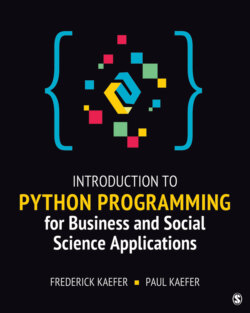Читать книгу Introduction to Python Programming for Business and Social Science Applications - Frederick Kaefer - Страница 68
Glossary
ОглавлениеArithmetic operatorsSymbols used to add, subtract, multiply, divide, and exponentiate (raise to a power) values.Assignment statementsPython code statements used to specify what value something is to take. Read from right to left, in which you assign the value on the right-hand side of the equal sign to the variable on the left-hand side of the equal sign.BooleanData type that can have either True or False logical values.ClassesUsed to create objects.CommentsBegin with a pound sign (#). The interpreter does not process comments.ConcatenationOperation that combines multiple strings into one string.Data typeSpecific attributes that determine the kind of values a piece of data can have and the kind of operations performed on the data.defPython keyword that is at the beginning of every function definition.ExceptionOccurs during Python code execution when you attempt an action that is not possible or not allowed.FloatData type, which can have decimal values.FunctionSubroutine of code developed to perform specific tasks.IndentationThe number of spaces and/or tabs at the beginning of a line of Python code.IntegerData type that can store whole numbers.Logic errorOccurs when a program executes without terminating with an error condition but produces incorrect results.MethodAn action that can be done to or with an object.ObjectsThe building blocks of Python. Objects or relations between objects represent all data in a Python program.StringData type, which can have text made up of letters, characters, and numbers. Enclosed in quotes when referenced in code.Syntax errorOccurs when Python code does not follow the rules that dictate the specification of Python code statements.type functionUsed to determine the data type of an object.VariableUsed to store and access values.
